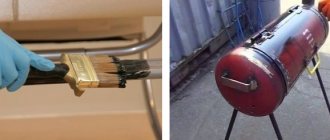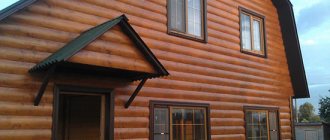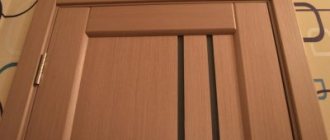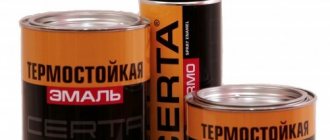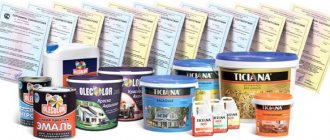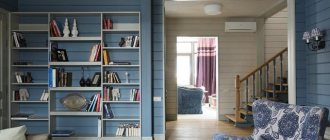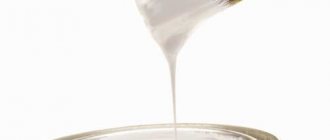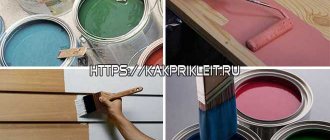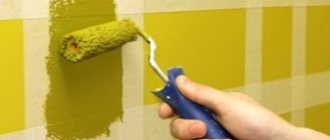Dye markings with interpretation
In accordance with current Russian standards (GOST 9825-73), a combination of 2 letters of the Cyrillic alphabet and 2-4 Arabic numerals separated by a dash is used for marking paint and varnish products.
Information about what type of paint the paint belongs to is always indicated on the packaging.
For example, code PF-155 indicates:
- PF – pentaphthalic base material;
- 1 – weather resistance;
- 15 – composition with serial number 15 (assigned when creating enamel).
Additional information on components is available in certification documents or GOST standards (applies to Russian-made products). The type of paint and varnish material (for example, enamel, primer) is always indicated before the code. For a number of materials, a letter indicating the type is placed in front of the digital combination (B - without solvents, V - water-based or VD - water-dispersed compositions, O - organic-dispersive and P - powder). If an additional identifier is introduced, it is separated from neighboring groups by dashes.
Common encodings of the base base for construction or repair enamels (for both external and internal work):
- PA – polyamide;
- PC – polyacrylate;
- AC – based on copolymer compounds of polyacrylic;
- AC – cellulose acetate;
- BT – bitumen;
- VA – polyvinyl acetate;
- VL – polyvinyl butyral;
- VN – vinyl or vinyl acetate;
- GF – glypthal;
- ZhS – containing alkali metal silicates (liquid glass);
- KK – based on natural resin (rosin);
- UR – polyurethane;
- KCh – rubber;
- NC – nitrocellulose;
- PF – pentaphthalic;
- FM – phenolic-oil;
- EC – ethylcellulose.
To indicate the primary purpose, digital codes are used:
- 0 – primers and varnishes, semi-finished products for the production of other paints and varnishes;
- 00 – putty (regardless of purpose);
- 1 – weather resistant;
- 2 – intended for indoor use (limited weather resistance);
- 3 – allowing preservation of metal structures;
- 4 – resistant to hot water and steam;
- 5 – designed for application to fur or leather products or having specific properties (for example, resistance to x-ray radiation);
- 6 – resistant to petroleum products (motor oil or fuel);
- 7 – intended for painting structures operating in aggressive environments (acids or alkalis and their vapors);
- 8 – resistant to temperature influences;
- 9 – having electrical insulating properties.
The Russian standard allows for the designation of the type of drying oil that is included in the material:
- 1 – natural;
- 2 – oxol;
- 3 – glyphthalic;
- 4 – pentaphthalic;
- 5 – combined.
Imported paints and varnishes are marked in accordance with regional and international standards. There are Russian designations with fewer numbers in the code. For example, the MA-25 index indicates an oil-based enamel (MA) intended for interior use (2), containing a combined drying oil. The designation always indicates the shade of the material (for example, red-brown or blue).
For proper use of paint, it is important for the consumer to know what the markings on the label or special insert mean.
When there is a wide variety of options, colors are indicated with an additional numerical identifier (for example, yellow-1 or yellow-2, the number indicates the shade). The standard allows the shade to be specified in accordance with the sample file with the introduction of a code in the database (for example, gray 571).
Due to the large number of designation options, it is difficult for a novice painter to understand the types of enamels, so it is recommended to contact a store consultant or invite an experienced selection specialist.
Film formers
Paints contain film formers, which often serve as a link between different substances. The production of DCM materials includes a larger number of binding components, which makes the production of paints and varnishes a rather labor-intensive and high-tech process, which is monitored by the majority of skilled equipment, including people. Paints and varnishes are divided into several types and often have several subtypes of a particular category. The production of paints and varnishes also includes a solvent, which in most known types and subtypes of paints has the property of reducing the viscosity of the paint, which in turn facilitates the application of paints and varnishes to the surface. The solvent is one of the few connecting links in paint and varnish products. The solvent is based on quite common substances, such as water, alcohol, oil and other substances containing hydrocarbons. All this often complicates the technology for creating coatings and the production process.
Water based paints
Materials based on distilled water are intended for both internal and external use. They contain additional binding components that determine the layer’s resistance to external (mechanical, temperature or atmospheric) influences. For application, use brushes, rollers (with coats made of any material), as well as sprayers. The painting method is chosen depending on the area and orientation of the surfaces in space.
The advantage of water-based paints is their environmental safety.
Emulsion dyes
Emulsion materials are a suspension of pigment and additional components in water; after the moisture evaporates, they form a durable protective layer (resistant to precipitation and washing). Use warm water to remove fresh paint from tools or clothing. The compositions are characterized by increased environmental friendliness (when applied and dried, no substances harmful to humans are released into the air). The coating has microscopic pores that allow moisture to be removed from the base.
Acrylic paints
The materials are based on acrylic resins and have increased elasticity. The coating allows you to cover cracks up to 0.5 mm wide, does not collapse and does not lose color when exposed to ultraviolet radiation. Acrylic enamels provide protection of the base from the penetration of water from the outside (for example, they are used for painting concrete structures with reinforcing mesh or rods). Paints and varnishes have high adhesion (when applied to a dry surface) and are resistant to external mechanical influences.
Textured plasters
The group of water-based paints includes textured plasters containing admixtures of granite or other minerals. After the moisture evaporates, a decorative layer with a rough surface remains on the surfaces; the pigments introduced into the composition make it possible to imitate natural finishing materials. Plaster allows you to seal uneven areas and cracks in walls or ceilings.
To obtain an original relief pattern, rollers with a silicone roller are used (for example, to imitate brick or stone masonry).
Polyvinyl acetate
Emulsion-type enamels containing polyvinyl acetate (PVA), pigments and additives to stabilize and impart elasticity to the coating. The industry offers ready-to-use materials and paints made from 2 components (plasticizer and pigment), which must be mixed before application. It takes 2-3 hours for the moisture to evaporate; a semi-matte, uniform film is formed on the painted surfaces, resistant to base deformation and condensation.
Latex dyes
The materials include a suspension of synthetic latex (on an acrylic, urethane, polyvinyl acetate, siloxane or styrene-butadiene base), which forms an elastic film together with pigments. The coating follows the contours of the surfaces and withstands external loads. The layer is permeable to air, is not destroyed by cold and hot water, and does not lose pigmentation under the influence of ultraviolet radiation or chemical reagents (for example, detergents).
Latex paint is characterized by increased wear resistance.
Silicone dyes
The binder is silicate resins; the resulting coating is not washed away by water, but allows air to pass through. The layer is highly elastic; cracks up to 2 mm wide can be painted over without filling with putty. The paints are designed for application to plaster 2 days after finishing; the material has antibacterial properties and can be cleaned with both water and special chemicals.
Enamels are used for any type of mineral coating (for example, brick or concrete walls or ceilings).
Mineral compositions
Materials based on crushed minerals are intended for finishing facades made of brick, concrete, or used during restoration or repair work. Paints are often dry (in powder form), which are diluted to the required consistency with water. After hardening, the layer allows evaporation to pass through, allowing excess moisture to be removed, extending the life of building facades. To change the characteristics (for example, adhesion to the base or plasticity), synthetic resins are introduced into the composition.
Mineral compositions are divided into categories on a basic basis:
- lime (based on slaked lime) with inorganic dyes of light shades;
- cement (with the addition of Portland cement), contain slaked lime and calcium chloride;
- silicate, consisting of alkali-resistant pigments and filler;
- oil, consisting of a mixture of pigments and drying oil with the addition of a drier and additives that reduce the likelihood of sediment formation.
Price and quality of paints
Among the listed types of paints and varnishes there are much cheaper varnishes and, in turn, this type of varnish dries quite quickly; this is a type of nitrocellulose varnish. For all its advantages, this type of varnish is made from quite toxic additives. To use this type of varnish, you should not forget about precautions; when working with varnish and not only this type, you should wear a respirator, gas mask and other means of protecting the respiratory tract and mucous membranes.
When working with this varnish in a room after work, it is worth ventilating until the smell disappears completely, since the smell of this varnish lasts longer than others. These varnishes also have some disadvantages, one of them is minimal moisture resistance, but this is no longer such a problem, since this type of varnish already exists that is moisture resistant. So, despite its two advantages, this type of varnish has many disadvantages, which will stop some from using this type of paint and varnish.
Based on organic solvents
Paints and varnishes based on organic solvents (for example, white spirit or solvent) are intended for external and internal work. When applied and dried, fumes are released that negatively affect human health. Work must be carried out in rooms with forced ventilation; the painter should use protective gloves and a respirator. Enamels are applied manually or with a spray gun (coatings with increased absorbent characteristics are pre-primed).
Alkyd dyes
Enamels are based on alkyd varnish (glyphthalic or pentaphthalic), diluted with turpentine or white spirit. The composition includes pigments that determine the shade, fillers (for example, oils to increase the elasticity of the coating, or sand or granite chips to form a rough layer). Enamels for wooden structures contain antiseptic additives to protect the base from fungi and rot.
Alkyd paints, after drying, form very durable, waterproof and chemically inert surfaces of varying degrees of gloss.
Enamels
The materials are intended for painting metal, wood, plastic, and concrete structures. To change the shade, various types of pigments are used that are dissolved in the varnish. After polymerization, a smooth, shiny coating is formed; it takes from 15 to 45 minutes to harden. Enamels are suitable for exterior and interior use; they may contain components that neutralize rust. The layer can withstand prolonged exposure to ultraviolet radiation and is neutral to precipitation and temperature changes.
Oil paints
Paints consist of organic or synthetic drying oil or oil in which pigments and additives are dissolved. To increase fluidity, organic solvents are used (for example, turpentine, purified gasoline or solvent). The materials have a low cost and final price, but it takes several days to harden. Artistic oil-based enamels dry after 12-14 months. When exposed to sunlight and air, the coating acquires a yellowish tint.
Purpose
Paints can be intended for coloring the surfaces of canvases to create paintings, paintings, and for obtaining decorative coatings. After drying, absorption or polymerization, paints form a colored, uniform film, usually opaque or translucent.
There are specialized paints for the human body - hair dye, nail polish, makeup paint, tattoo paint.
Special types of paints are also used in confectionery products - food coloring.
Specialized types of paint pigments are considered effective
[13]:
- heat sensitive (change color when temperature changes)
- Phosphors (pigment that glows in the dark)
- “Chameleon” (the effect is based on the reflection and refraction of a light beam with different wavelengths at different angles on a painted surface. Pigment layers include fine-grained particles approximately 1-5 microns in size, located at different levels of the coating).
Another very important purpose of paints is to protect the material of the surface being painted from external factors. They protect metals from corrosion, and wood from loss of moisture or its excess, rotting, as well as exposure to insects[14].
Silicate dyes
Enamels are based on liquid glass and are mineral. Used for painting facades of residential buildings and office buildings. The compositions are resistant to external climatic influences, are not washed away by water, but allow air and liquid vapors to pass through. Before application, it is recommended to treat absorbent materials with silicate primer. The dyes are not designed for treating walls that have old paintwork with acrylic or alkyd enamels; they do not adhere to smooth surfaces (for example, ceramics, polished stone, metals).
Silicate paints are made on the basis of liquid glass.
Literature
- Mendeleev D.I., Lidov A.P.
Organic natural paints // Encyclopedic Dictionary of Brockhaus and Efron: in 86 volumes (82 volumes and 4 additional). - St. Petersburg, 1890-1907. (Date accessed: April 18, 2011) - Mendeleev D.I., Gemilian V.A.
Organic artificial paints // Encyclopedic Dictionary of Brockhaus and Efron: in 86 volumes (82 volumes and 4 additional). - St. Petersburg, 1890-1907. (Date accessed: April 18, 2011) - Mendeleev D.I., Lidov A.P.
Mineral paints // Encyclopedic Dictionary of Brockhaus and Efron: in 86 volumes (82 volumes and 4 additional). - St. Petersburg, 1890-1907. (Date accessed: April 18, 2011) - Petrushevsky F. F.
Paints used for painting // Encyclopedic Dictionary of Brockhaus and Efron: in 86 volumes (82 volumes and 4 additional). - St. Petersburg, 1890-1907. (Date accessed: April 18, 2011) - Animal colors // Encyclopedic Dictionary of Brockhaus and Efron: in 86 volumes (82 volumes and 4 additional). - St. Petersburg, 1890-1907.
- Korsunsky L. Stability of modern artistic oil paints
// Artist. 1962, No. 10. P.56-58.
To improve this article it is desirable:
After fixing the problem, remove it from the list. Delete the template if all defects have been resolved. |
Glue dyes
Adhesive materials contain organic or synthetic substances that provide improved adhesion. They are used for interior work and can be applied manually using rollers or pneumatic spray guns. A common disadvantage is low resistance to water and humid air. The liquid gradually erodes the glue and pigments, so enamels are used to a limited extent for painting structures located in the open air.
Casein paints
The dyes are based on organic protein compounds (casein glue), which provide good adhesion to concrete and brick walls (both plastered and unfinished). They can have different shades due to tinting (manual or computer), and are characterized by reduced resistance to external atmospheric conditions.
When applied to facades, they retain their original color for 1-2 years, then gradually fade and are washed away by precipitation.
Dextrinated
The materials contain bone glue, which is characterized by low resistance to moisture. Enamels are easily applied to walls and ceilings and are designed for long-term use in dry conditions (up to 5-6 years). Under the influence of carbon dioxide contained in the air, they degrade and lose their original bright shades. In poorly ventilated areas, pockets of mold form on the layer (due to the natural decomposition of the components of the adhesive mass).
Adhesive paints
Classic adhesive dyes contain water-based glue and do not emit harmful fumes during painting and drying. The characteristics correspond to emulsion enamels, but they are washed away by water and destroyed under the influence of moist air. Designed for painting rooms equipped with heating systems (centralized or individual). Supplied in powder form, which is diluted with water before application (the shade can be changed by introducing additional pigments).
Adhesive paints are similar to acrylic emulsions, but are less resistant to moisture and are only suitable for dry rooms.
Notes
- Painting 101: Oil or Latex? (undefined)
. - What's the Ideal Outdoor Temperature Range for Using Exterior Paint? (English).
- Craughwell, Thomas J., 1956-.
30,000 years of inventions. - New York: Tess Press, 2012. - ISBN 9781603763240. - Hillary Mayell.
Stone Age painting kits found in cave?
(undefined)
.
National Geographic News
2 (March 31, 2004). — “Work published in 2001 described 28 bone tools and thousands of pieces of ocher—a mineral used to create paint for body decoration and cave painting—dated at roughly 70,000 years old found in Blombos Cave in South Africa. Two pieces of ocher appear to be marked with abstract lines that could be viewed as artistic expression.” Date accessed: May 20, 2016. - ↑ 1 2
The oldest human workshop for making paints was discovered in the cave
(unspecified)
.
The Guardian
(13 October 2011). Date accessed: May 20, 2016. - Stephanie Pappa.
Oldest Human Paint-Making Studio Discovered in Cave
(unspecified)
.
Live Science
(October 13, 2011). Access date: October 14, 2011. - Painted walls in Orkney 5,000 years old
,
BBC News
(26 July 2010). - Painted walls (English) (undefined)
.
The Ness of Brodgar Excavation
(August 5, 2011). Date accessed: March 10, 2022. - "Oldest Oil Paintings Found in Afghanistan" Archived June 3, 2011, Rosella Lorenzi, Discovery News. Feb. 19, 2008.
- Theophilus Presbyter Book I ch. 25
- Barbera, Giocchino.
Antonello da Messina, Sicily's Renaissance Master. — New York: Metropolitan Museum of Art Yale University Press, 2005. ISBN 0-300-11648-9 (online), p. 14 - Ploeger, Rebecca (2013). “Characterization and Stability Issues of Artists' Alkyd Paints” (PDF). New Insights into the Cleaning of Paintings: Proceedings from the Cleaning 2010 International Conference, Universidad Politécnica de Valencia and Museum Conservation Institute
.
3
: 89–91. - Kaverinsky V.S., Kaverinsky D.V.
Innovative ways to create new color and optical effects (Russian) // Paints and varnishes and their application: journal. - 2022. - No. 11. - P. 38-42. — ISSN 0130-9013. - Fire protection of wooden structures is a standard in the modern world and contains a class of substances such as fire retardants
- Sergey Apresov.
Check it seven times: how to recognize a fake (Russian) // Around the World: magazine. — 2022. — December (No. 12). - see powder coating
- Bramley, Christopher Sinjin
Color changing paint
(undefined)
.
European Patent Application EP1400574
. European Patent Office. - Bulletin of foreign commercial information, No. 103, 09.11.08, p.14
- "Data from the Federal State Statistics Service"
- Reference to the article “Corundum will color Russian Railways” (inaccessible link) “Business Petersburg” ISSN 1606-1829 (Online) October 3, 2007
- SPURGEON A (2006). “Watching Paint Dry: Organic Solvent Syndrome in late-Twentieth-Century Britain.” Medical History
.
50
(2): 167–188. DOI:10.1017/s002572730000973x. PMC 1472097. PMID 16711296. - Ethylene Glycol Mono-N-Butyl Ether (undefined)
. National Library of Medicine HSDB. Access date: March 14, 2014. - South Korea expands VOC controls and tightens limits in paint (undefined)
.
chemicalwatch.com
. Date accessed: March 27, 2022. - Volatile Organic Compounds (VOC) and Consumer Products Regulations (undefined)
.
www.chemsafetypro.com
. Date accessed: March 27, 2022. - Chang, John C.S.; Fortmann, Roy; Roache, Nancy; Lao, Huei-Chen (1999). “Evaluation of Low-VOC Latex Paints.” Indoor Air
[English].
9
(4): 253–258. DOI:10.1111/j.1600-0668.1999.00004.x. ISSN 0905-6947. PMID 10649858. - Hu, D; Hornbuckle, K. C. (2010). “Inadvertent polychlorinated biphenyls in commercial paint pigments.” Environ Sci Technol
.
44
(8): 2822–7. Bibcode:2010EnST…44.2822H. DOI:10.1021/es902413k. PMC 2853905. PMID 19957996.
Special dyes
To paint facades and perform decorative work, special enamels are used to obtain a relief surface. There are paints with a narrow purpose (for example, for obtaining seal impressions or for printing designs on clothing or paper). When selecting special dyes, you should take into account the specifics of the work being performed.
Structural
Structural enamels contain thickeners and insoluble powders that allow the formation of a rough coating (for example, imitating the structure of wood or ripples on the surface of water). After polymerization, the surface is coated with latex and acrylic-based dyes that provide the required color range.
It is possible to add pigment to the structural material before application, which simplifies the painting technology and reduces the cost of painting or finishing work.
Decorative
Decorative paints are designed to imitate a special coating (for example, leather, old wood or natural stone). The pigments introduced into the composition can have a pearlescent or metallic effect or shimmer in several shades. They are distinguished by their high price and demanding qualifications of the painter; enamels are used indoors. When applied to the external parts of houses, they quickly lose their original appearance (the disadvantage is partially compensated by a layer of glossy synthetic varnish that can withstand climatic influences).
Decorative paints are designed to create imitation surfaces.
Stamp
The materials contain pigments, glycerin and a solvent (water, alcohols or solvent). They are used for applying stamps to paper; they penetrate well into surface layers, thereby complicating the etching procedure. Stamp inks are applied to special foam pads, which are installed in the stamp tray. The materials do not contain aggressive components that destroy cliches.
For facade
Facade paints and varnishes protect walls from mechanical damage and precipitation, and give the building an original design. Enamels can be based on silicate, rubber, emulsion or acrylic base. The coating should not be destroyed under the influence of ultraviolet radiation and has a maximum service life (from 7 to 20 years).
Lime façade materials, used for budgetary or temporary repairs, stand apart.
Aerosol
For accelerated application, water-based or synthetic-based enamels are used, packaged in aerosol cans with a capacity of up to 1 liter. Before use, shake the tank vigorously for 2-3 minutes, and then spray the material onto the surface at a distance of 200-300 mm. To obtain an even coating, it is recommended to apply 2-3 layers; for additional protection, use glossy or matte varnish.
Aerosol paint is indispensable when painting small parts and hard-to-reach surfaces.
Flexopaint
The materials are intended for printing on paper, metal or fabric surfaces; water, alcohols (for example, isopropanol, which replaces ethanol) or solvent are used as a solvent. The composition includes coloring additives, binders and additives to adjust the characteristics of the layer (for example, elasticity or resistance to temperature changes). The materials contain polyamide or polyurethane resins or nitrocellulose; some enamels are flammable.
Content
- 1. History
- 2 Purpose
- 3 Composition of paints 3.1 Pigments
- 3.2 Behavior of the pigment in the infrared and ultraviolet range
- 3.3 Binders
- 3.4 Thinner, thinner or solvent
- 3.5 Fillers
- 5.1 Production
Comparison of the presented compositions
Paints and varnishes differ in the base base, pigment characteristics and solvents that determine drying time. The owner of an apartment or residential building who decides to independently renovate the premises needs to select enamels depending on the type of work.
To select, you can use the factory instructions or contact a consultant at a building materials store.
Scope of use
The scope of application of enamels depends on the base used:
- Water-based paints are intended for external and internal use, but the characteristics of the coating should be taken into account. For example, emulsion materials are intended for painting any surface, except for products coated with adhesives or glossy enamel. Acrylic enamels are used for painting window frames and blocks, door frames and canvases. Before application, uneven surfaces are filled with putty and a layer of primer is applied to reduce the absorbency of the plaster or wood.
- Latex compounds are recommended for use in rooms with high humidity (for example, in the bathroom or kitchen). For application, use a roller or spray.
- Alkyd enamels are used to paint heating radiators, door and window blocks. The coating is characterized by increased strength and does not collapse due to temperature deformations. It is allowed to use varnish-based alkyd enamels that provide a smooth and shiny surface instead of alkyd enamels. All synthetic enamels emit toxic fumes; the materials should not be used for painting children's rooms.
- Silicate compounds are designed for painting external surfaces. The alkali they contain has a negative effect on the eyes and skin, so before performing work it is necessary to wear safety glasses and gloves. The coating does not protect the base from water; before application it is recommended to level the surfaces and seal cracks.
- Special dyes are based on a water or synthetic base and, due to the introduction of additives, have limited applicability. For example, aerosols are used for painting small products or for minor repairs.
Color palette
The range of shades of paints and varnishes depends on the manufacturer. Manufacturers allow tinting of water-based enamels upon sale.
Thanks to a service such as computer tinting, you can get any shade of paint.
At the buyer's request, a portion of pigment is introduced into the white material (selection is carried out using a computer in accordance with RAL tables), and then the components are mixed on a vibration stand. It is recommended to prepare a batch of enamel with a reserve; when re-tinting, shade deviations may occur. Materials based on a synthetic base are supplied ready for application (the addition of pigment is not provided).
Advantages and disadvantages
The positive aspects of water-based materials include:
- environmental friendliness (enamels do not emit harmful fumes; a slight odor may be felt during painting and drying);
- resistance to alkaline solutions, moisture (repeated washing is allowed);
- the ability to maintain the original shade when exposed to sunlight;
- fast polymerization (from 1 to 6 hours depending on external conditions);
- ease of repainting and long service life.
Disadvantages noted by painters:
- low resistance to low temperatures;
- Painting surfaces with a glossy finish is not allowed;
- reduced mechanical strength (compared to synthetic-based enamels).
When using synthetic paints, their positive aspects should be taken into account:
- durability of the coating that can withstand impacts;
- no shrinkage during polymerization;
- speed of hardening.
At the same time, it is necessary to remember the shortcomings. When painting and drying, toxic vapors of solvents and resins, which have a pungent and unpleasant odor, enter the air. The dense layer that forms does not allow air and water vapor to pass through, and the wooden base can swell and rot. Enamels are flammable (vapors form explosive mixtures when mixed with air). You should also take into account the low resistance of the paintwork to alkaline solutions.
Color change
There are various technologies for making color changing paints. Thermochromic paints and coatings contain materials that change shape when heat is applied or removed, and therefore they change color.
Liquid crystals have been used in inks such as thermometer strips and tapes used in aquariums, and in thermostacks and straws for novelty/promotional materials. Photochromic materials are used to make glasses and other products. Like thermochromic molecules, photochromic molecules change conformation when light energy is applied or removed, and therefore they change color.
Color-changing paints can also be made by adding halochromic compounds or other organic pigments. One patent[17] mentions the use of these indicators to cover walls with light-colored paints. When the paint is wet, it is pink in color, but once it dries it returns to its original white color. As stated in the patent, this property of the paint allows two or more layers to be applied correctly and evenly to the wall. The previous dry layers will be white, while the new wet layer will be distinctly pink. Ashland Inc. introduced castable refractory coatings with a similar principle in 2005.
Electrochromic paints change color when exposed to electric current. Car manufacturer Nissan is reportedly working on an electrochromic paint based on paramagnetic iron oxide particles. Under the influence of an electromagnetic field, paramagnetic particles change distance, changing their color and reflective properties. The electromagnetic field will be formed from the conductive metal of the car body. Electrochromic paints can also be applied to plastic substrates using a different coating chemistry. The technology involves the use of special dyes that change shape when an electric current passes through the film itself. This new technology is being used to provide one-touch anti-glare protection in passenger aircraft windows.
Color can also change depending on viewing angle using iridescence, such as in ChromaFlair.
Types of artistic paints
The following types of dyes are used for artistic work:
- watercolors and gouaches, forming a water-soluble layer;
- materials based on oil or drying oil that require long-term drying;
- tempera and acrylic materials, characterized by increased resistance to external factors.
Artistic paints are made from pigments, binders and fillers.
Watercolor
The paint consists of pigments and binders based on complex carbohydrates; the materials are easily dissolved and washed off with water. When dissolved, it forms suspensions of varying concentrations, allowing you to adjust the color intensity and provide an easy transition between shades. The disadvantage is the low resistance of the coating to sunlight; to ensure safety, the drawings must be covered with curtains or placed in albums.
Oil
The materials contain suspensions of organic or inorganic pigments that are dissolved in vegetable oil or drying oil. The composition contains additional components that affect the strength of the layer and drying time. Oil paints are usually divided into paste or thickly grated and liquid, ready for application. Regardless of the type, application in a thick layer is not recommended; complete evaporation of the solvent takes up to 1 year.
Gouache
The composition of gouache includes pigments, whitewash or kaolin (to obtain a matte velvety structure) and adhesive mass. When painting, remember that as water evaporates, the color of the paint fades. When applied in a thick layer, cracking of the coating is observed; the deficiency is compensated by the introduction of wood glue. The dye hardening time ranges from 30 minutes to 3 hours, depending on air humidity. There are special fluorescent gouaches intended for decorative or design work.
Tempera
The material consists of powdered pigment diluted with distilled water. To ensure the strength of the coating, natural or artificial emulsions are used (for example, egg yolk or a mixture of casein and oil dissolved in water). There are temperas with the addition of polyvinyl acetate, acrylic or wax-oil composition. When dried, the material loses its original shade (darkens or lightens), which should be taken into account when using.
Story
Rock painting of Megaloceros from Lascaux (France), charcoal and ocher.
Paint was one of the most ancient arts of mankind. Some cave paintings, painted with red or yellow ochre, hematite, manganese oxide and charcoal, may have been created as early as 40,000 years ago.[3] In 2003 and 2004, South African archaeologists reported the discovery in Blombos Cave of a 100,000-year-old ocher-based artificial mixture that could be used as a paint.[4][5] Further excavations in the same cave led to a 2011 report of a complete set of tools for crushing pigments and making a substance similar to primitive paint that had survived for 70 thousand years.[5][6]
The interior walls of 5,000-year-old Ness Brodgar were found to include individual stones painted yellow, red and orange using an ocher pigment made from hematite mixed with animal fat, milk or egg white.[7][8]
Ancient colored walls in Dendera, Egypt, which have been exposed to the elements for years, still exhibit vibrant color as vibrant as when they were painted some 2,000 years ago. The Egyptians mixed their colors with a sticky substance and applied them separately from each other, without mixing or blending. They seem to have used six colors: white, black, blue, red, yellow and green. They first covered the entire area in white, then outlined the design in black, eliminating the lights of the main color. They used carmine for the color red, usually a dark shade. The oldest known oil paintings are Buddhist murals created around 650 AD. The works are located in cave chambers carved out of the rocks of Afghanistan's Bamiyan Valley, "using walnut and poppy oils."[9] Pliny mentions some painted ceilings in his day in the city of Ardea, which were made before the founding of Rome. After so many centuries, he expressed great surprise and admiration at their freshness.
In the 13th century, oil was used to decorate tempera paintings. In the 14th century, Cennino Cennini described a painting technique using tempera painting covered with thin layers of oil. The slow drying properties of organic oils were widely known to early European artists. However, difficulties in obtaining and processing the materials meant that they were rarely used (and indeed slow drying was considered a disadvantage[10]). The Fleming-educated or influenced Antonello da Messina, who was erroneously credited by Vasari with introducing oil paint to Italy[11], appears to have improved the formula by adding litharge or lead(II) oxide. A surviving example of oil painting of 17th-century houses is Ham House in Surrey, England, which used ground, several primers and an elaborate decorative coating; the pigment and oil mixture would be ground into a paste using a mortar and pestle. The artists did it by hand and they were exposed to lead poisoning due to the white lead.
In 1718, Marshall Smith invented a "machine or engine for grinding paints" in England. It is unknown exactly how it worked, but it was a device that dramatically increased the efficiency of grinding pigments. Soon she began advertising exclusively inexpensive paints made using labor-saving technologies:
One pound of colored earth in a horse-mill will dye twelve yards of work, while colored earth by any other means will not do half that amount.
By the start of the Industrial Revolution in the mid-18th century, paint was ground in steam mills and an alternative to lead-based pigments was found in the form of a white derivative of zinc oxide. Interior painting of houses increasingly became the norm as the 19th century progressed, both for decorative reasons and because paint was effective in preventing walls from rotting from damp. Linseed oil was also increasingly used as an inexpensive binder. In 1866, Sherwin-Williams opened as a major paint manufacturer in the United States and invented a paint that could be used straight from the can without any prior preparation.
Artificial resins or alkyd compositions were invented only after there was a shortage of linseed oil in the World War II markets. Inexpensive and easy to make, they also held color well and lasted a long time.[12]
Egypt
Purple dye was first used by the Egyptians. For this, special snails were used. The required composition was obtained by mixing snail secretions and standard paint components. In turn, lime contributed to the production of white paint. Its advantage was its low cost and ease of manufacture.
An interesting find was discovered in the tombs of the pharaohs, namely ultramarine. Even after several thousand years, thanks to lapis lazuli, a special coloring pigment, the color scheme has not faded and retained its attractiveness. This coloring composition was very expensive in Ancient Egypt, so it was used to depict sacred symbols.
Lapis lazuli, from which ultramarine was made
Long before our time
The caveman expressed himself using charcoal, ocher and chalk. Experts say that the oldest rock painting is about 43,900 years old. The painting was preserved due to animal fats, which were used when mixing the paint. This made it possible to obtain strong and durable compositions.
Advances in the field of chemistry have allowed art to develop in a different direction, since the range of tools used has become much more diverse. Today, paints include elements such as glue, resin, and glycerin. Manufacturers offer synthetic and natural, organic and mineral paints.
Tips for choosing car paint
Most often, the need to paint a car arises after an accident or in the event of a natural decrease in the quality of the coating due to wear and tear.
The difficulty in choosing paint for a car is finding a shade that best matches the base color. In addition, car enthusiasts are guided by the cost of the product, the conditions for its use, the method of painting, operational features and, of course, individual preferences.
Basic criteria for choosing car paint:
- types of parts and total area of surfaces that need painting;
- the amount the owner is willing to spend. The quality of cheap formulations is often disappointing;
- conditions under which painting will be carried out - availability of special equipment, possibility of exposure to weather. It is better to entrust expensive paints and varnishes to professional craftsmen to avoid the risk of improper handling of the product;
- reputation and fame of the manufacturer. You should not buy products from manufacturers for which there are no reviews either on the Internet or from private craftsmen;
- paint performance characteristics. The most important property of any paintwork is considered to be strength and resistance to environmental influences. It is also worth paying attention to the paint’s ability to resist corrosion.
Separately, it is worth considering the methods of applying this or that composition. If the product cannot be applied with improvised tools, then you will need to purchase special equipment. And this entails additional costs.
Some types of materials are produced in the form of aerosols. Such paints seem easy to use, but in reality they require practical experience in use.
Each car enthusiast has his own preferences in choosing paints and varnishes. But the priority for everyone remains affordable and easy-to-use paints that protect the car surface from damage.
We hope that the review of car paints provided in this article will help you decide on the choice of paint for your car, both in case of repair and in case of external transformation. We wish you the right decision and excellent results.
Where to buy paints for painting?
Today, a large number of specialized stores have been created that sell creative goods. Their assortment includes a large number of paints for painting, which means you can easily choose the option you are interested in for yourself or your loved ones.
On video: experiment with watercolors.
You can also choose good paints in the online store. There is a reasonable price, a wide selection of different materials, delivery can be made directly to the door of your apartment. And the quality of paint and varnish products for painting is no different from store-bought ones. In this case, you can choose related products: brushes, solvents, palette, paper (or canvas) and much more.
